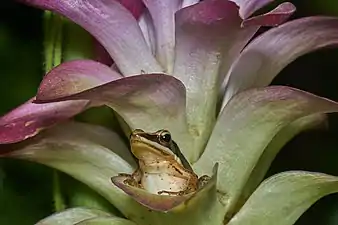Curcuma angustifolia
Curcuma angustifolia is one of over 80 species belonging to the genus Curcuma ,[3] in the family Zingiberaceae. This species is native to the Indian subcontinent and is more commonly known as East Indian arrowroot[2] or narrow-leaved turmeric in English, and is called "yaipan" in Manipuri, "Aipah" in Thadou-Kuki, "tikhur" in Hindi, and "Koova" കൂവ in Malayalam/Tamil, and is called "Kutupah" in Poula. In the Eastern hemisphere, the plant plays an integral role in many cultures.[4]
| Curcuma angustifolia | |
|---|---|
 | |
| Scientific classification | |
| Kingdom: | Plantae |
| Clade: | Tracheophytes |
| Clade: | Angiosperms |
| Clade: | Monocots |
| Clade: | Commelinids |
| Order: | Zingiberales |
| Family: | Zingiberaceae |
| Genus: | Curcuma |
| Species: | C. angustifolia |
| Binomial name | |
| Curcuma angustifolia | |

Description
Curcuma angustifolia is rhizomatous herb. It is a perennial and a flowering plant, with modest and small spiked inflorescences of three or four yellow, funnel-shaped flowers within tufts of pink terminal bracts (coma bracts).[4] The bracts are boat-shaped and encase the entire perianth of the flower. As is common to the genus, the flowers of C. angustifolia have double anthers, a slender style, and a globular stigma.[5] Flowers are usually seen at the beginning of the monsoon (rainy) season from July to August, before the leaves have had the chance to fully develop, and they continue to flower even after the leaves have fully developed.[4] The calyx of the flower is usually 1 cm (0.39 in) long and very hairy, with 3 lobes that may appear to be triangular or obtuse. The corolla is white, and usually grows to be about 1.5–2 cm (0.59–0.79 in) long with glabrous lobes that are also hairy. Seeds are a reddish-brown color.[6]
Leaves are typically simple, green, glabrous, and lanceolate, with margins that are entire. They appear in an opposite arrangement and are deciduous. They display fine parallel venation off of a central midrib. The upper surface of the leaves are usually a darker shade of green than the lower surfaces. Leaves may grow to about 36–37 cm (14–15 in) length and 8–10 cm (3.1–3.9 in) in width. The leaves also smell and taste similar to turmeric.[7]
Of great significance to C. angustifolia is its strong rhizome, which can grow to be up to 1.5 m (4.9 ft) in length. The rhizome of this plant is the primary source of its nutritive and medicinal properties.[4] C. angustifolia also uses its rhizome to reproduce asexually via vegetative propagation.[8]
The plant in its entirety typically grows to be from .9–1.2 m (3.0–3.9 ft) in height.[5]
Distribution and habitat
C. angustifolia is most commonly found growing wild in India, especially in the northeast and western coastal plains and hills. Such areas include the states of Maharashtra, Madhya Pradesh, Manipur, Andhra Pradesh, Himachal Pradesh, Orissa (Odisha), Chhattisgarh, Tamil Nadu, and Kerala. This species can also be found in Bangladesh, Burma, Laos, Nepal, and Pakistan.[4]
Cultivation
Curcuma angustifolia requires temperatures at or above 1 °C (34 °F). It prefers shady areas and grows best in moist soil that is sandy, pebbly, or loamy.[9][10] C. angustifolia is often found at the edges or in the clearings of forests.[6]
Common uses
While commonplace in Eastern culture and medicine, C. angustifolia has only recently earned the attention of the Western scientific community.[3]
Food uses
This species of plant has nutritional value as a source of starch for Indian foods. The rhizomes of C. angustifolia are typically ground into a flour which can then be mixed together with milk or water to form a nutritious meal. This flour was a common commercial crop in the 1800s.[4]
Most importantly, the West has begun to notice its potential as a source of nutrition and as a non-irritating diet for patients with specific chronic ailments, recovering from fevers, or experiencing irritations of the gastrointestinal tract, the lungs, or the excretory system. A drink including C. angustifolia as an ingredient is also used as a replacement of breast-milk, or as a nutritional supplement for babies a short while after weaning.[7]
It is found as a primary ingredient in cakes, fruit preserves, biscuits, and puddings.[7]
Medicinal uses
The rhizomes of C. angustifolia are used to soothe coughs and as such is used to treat bronchitis.[7]
Essential oils from C. angustifolia have been extracted and are used in antifungal medications. Compounds in the leaves of this plant have also been shown to have potential as antibacterial agents.[7]
See also
References
- "National Resources Conservation Service" group="United States Department of Agriculture""Plants Profile: Curcuma angustifolia Roxb". Retrieved 5 April 2012.
- Curcuma angustifolia was originally described and published in Asiatic Researches, or Transactions of the Society. Calcutta 11:338, t.5. 1810. "Curcuma angustifolia". Germplasm Resources Information Network. Agricultural Research Service, United States Department of Agriculture. Retrieved April 11, 2012.
- Sasikumar, B. (26 April 2005). "Genetic resources of Curcuma: diversity, characterization and utilization". Plant Genetic Resources. 3 (2): 230–251. doi:10.1079/PGR200574. S2CID 85913030.
- Ravindran, P.N.; Lutfun Nahar; Satyajit D. Sarker; J. Skornickova; T. Rehse; M. Sabu (2007). P.N. Ravindran (ed.). Turmeric: The Genus Curcuma. Florida: Taylor and Francis Group. pp. 4, 10–11, 43, 72, 458. ISBN 9781420006322. Retrieved 7 March 2012.
- Roxburgh, William (1832). W. Carey (ed.). Flora Indica (2 ed.). Serampore. pp. 20, 31–32. Retrieved 5 March 2012.
- Babu, C.R. (1977). Herbaceous Flora of Dehra Dun. New Delhi: Publications and Information Directorate. p. 501.
- Doble, Bhavana; Sumeet Dwivedi; Kushagra Dubey; Hemant Joshi (April–June 2011). "Pharmacognostical and antimicrobial activity of leaf of Curcuma angustifolia Roxb" (PDF). International Journal of Drug Discovery and Herbal Research. 1 (2): 46–49. Archived from the original (PDF) on February 2, 2014. Retrieved 17 March 2012.
- Shukla, S.K.; Susmita Shukla; Vijaya Koche; S.K. Mishra (April 2007). "In vitro propagation of tikhur (Curcuma angustifolia Roxb.): A starch yielding plant". Indian Journal of Biotechnology. 6: 274–276.
- "Hortipedia: The GardenInfoPortal"
- "Curcuma angustifolia". Retrieved 28 March 2012.